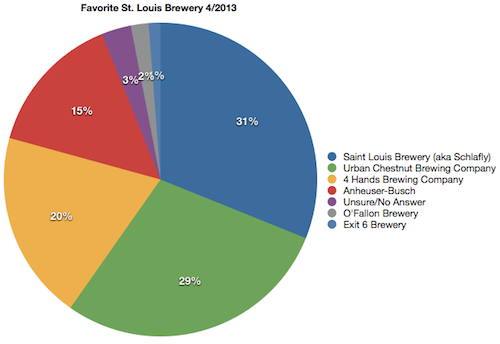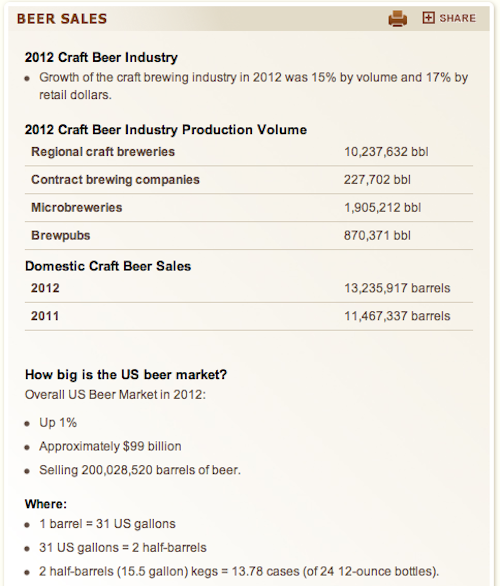Readers Favorite St. Louis Brewery: Schlafly
The three breweries came out ahead of Anheuser-Busch InBev together received nearly 80% of the votes in the poll last week:

Here’s the detailed results of the non-scientific poll:
Q: What is your favorite St. Louis brewery?
- Saint Louis Brewery (aka Schlafly) 51 [31.1%]
- Urban Chestnut Brewing Company 47 [28.66%]
- 4 Hands Brewing Company 32 [19.51%]
- Anheuser-Busch 24 [14.63%]
- Unsure/No Answer 5 [3.05%]
- O’Fallon Brewery 3 [1.83%]
- Exit 6 Brewery 2 [1.22%]
Remarkable given the short history of smaller brewers in the US.
The battle between craft breweries and big beer stretches back to the 1990s, when the idea of buying a beer brewed by a small, independent brewery first took off. In 1991, annual volume growth of microbrewing was 35 percent. Four years later, it had leapt to nearly 60, according to the Brewers Association. (US News — Hopslam: How Big Beer Is Trying to Stop a Craft Beer Revolution)
Indeed, Tom Schlafly later recalled the start of Schlafly beer after the son of a former law partner convinced him a market existed:
It was Dan who finally convinced me that a microbrewery would be viable in St. Louis. For a number of reasons, we concluded that the best plan would be to start with a brewpub.
In 1990, the Missouri General Assembly passed a law that allowed microbreweries (defined as breweries that produced no more than 2,500 barrels per year) to hold retail liquor licenses for the brewery premises. They were not allowed to sell beer anywhere else. In 1991, we were issued the first microbrewery license in the state of Missouri and opened The Schlafly Tap Room on December 26 of that year.
Soon thereafter, owners of other bars and restaurants began asking us how they could offer Schlafly Beer and were amazed to be told that the Missouri General Assembly wouldn’t allow us to sell to them. Responding to these requests, in 1993, I successfully lobbied the General Assembly to amend the Missouri microbrewery law to allow us to brew up to 10,000 barrels per year and to sell our beer to licensed wholesalers. In August of that year, several bars and restaurants in St. Louis began serving Schlafly.
In 2003, we opened Schlafly Bottleworks where we now brew most of our beer including almost all of our packaged beer. In 2008, we brewed approximately 25,000 barrels of beer and owned two restaurants, The Schlafly Tap Room and Schlafly Bottleworks. In 2009, we brewed over 30,000 barrels. We reached this point without amending the law that restricted microbreweries to 10,000 barrels of annual production. How did we do this? Easy. We’re now licensed as a winery. That’s right. In the eyes of the law, Schlafly Brewery is a winery.
Like microbreweries, Missouri wineries are allowed to hold retail liquor licenses on their premises. Unlike microbreweries, however, wineries are not subject to an annual production limit. Because we make cider, we can qualify as a winery (cider being considered wine because it’s made from fruit juice). As bizarre as it might seem that a brewery could be licensed as a winery, it’s even more bizarre that Schlafly is now the largest American-owned brewery in St. Louis (Anheuser-Busch is now owned by a Brazilian-Belgian conglomerate) (CraftBeer.com)
Dan Kopman became Tom Schlafly’s partner in St. Louis Brewery. Recently they sold a majority stake (60%) in the company to a group of local investors, Kopman still runs the operation. Interesting they started with a Brewpub, the Tap Room.
Many comments on the original post focused on the fact I only included breweries as listed by stlhops.com so brewpubs like Civil Life and Perennial were not choices. I did this to avoid controversy….
I’ve learned there as many terms in the beer business: microbrewery, brewpub, craft brewery, etc…
That last one is defined as:
An American craft brewer is small, independent and traditional.
Small: Annual production of 6 million barrels of beer or less. Beer production is attributed to a brewer according to the rules of alternating proprietorships. Flavored malt beverages are not considered beer for purposes of this definition.
Independent: Less than 25% of the craft brewery is owned or controlled (or equivalent economic interest) by an alcoholic beverage industry member who is not themselves a craft brewer.
Traditional: A brewer who has either an all malt flagship (the beer which represents the greatest volume among that brewers brands) or has at least 50% of its volume in either all malt beers or in beers which use adjuncts to enhance rather than lighten flavor. (Brewers Association)
And craft beer sales continue to climb, taking away sales from the big guys:

Note how the Craft Brewers Association distinguishes between:
- Regional craft brewers
- Contract brewing companies
- Microbreweries
- Brewpubs
I still have a lot to learn.
A close second on the list was the 2-year old Urban Chestnut Brewery which just announced a second location that will be larger than the Schlafly Bottleworks:
Once the new brewery is open, Urban Chestnut initially will be able to boost its annual production by about 15,000 barrels of beer. The new facility will eventually have capacity for 100,000 barrels a year. (One barrel equals 31 gallons, or about 330 regular-size bottles.) (stltoday)
Another brewer not on the list was William K. Busch Brewing Co.:
Brentwood-based William K. Busch Brewing Co., founded by Billy Busch, a son of former Anheuser-Busch leader August A. “Gussie” Busch, introduced Kräftig lager and Kräftig light in November 2011.
“We did the first year without TV, and we want to take the company to the next level,” Busch said.(stltoday)
Currently Busch’s new company is smaller than Schlafly, but it wants to brew a couple million barrels a year, still a small sum compared to the brewery founded by his ancestors.
— Steve Patterson
The end of your original link (to stlhops.com) says it well: “Regular readers will probably notice that there are a lot of places missing off of this list, and that’s true. There are just so many places in St. Louis that are doing a great job serving and selling craft beer that it’s difficult to keep up.” The important thing is to enjoy our local beer and to support our local brewers, be it at a brewery, a brewpub, a bar or a restaurant featuring local brews.
Best beer is hands down Perennial Artisan Ales. Beer geeks all around the country would trade you every beer in their cellar to get one bottle of BA Abraxas.